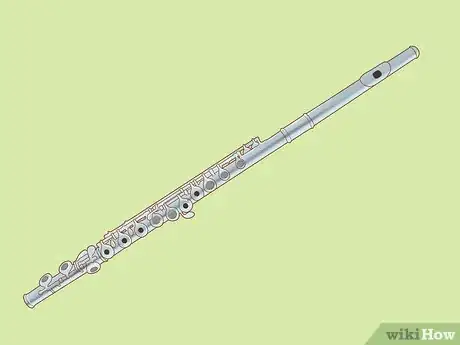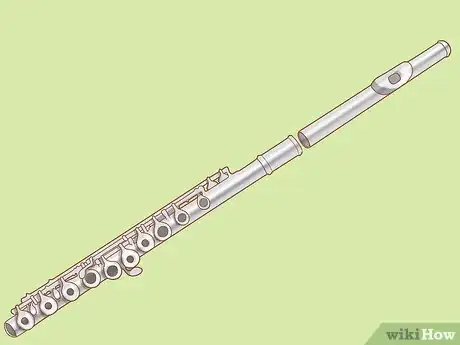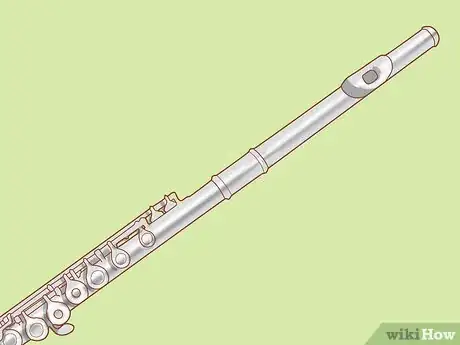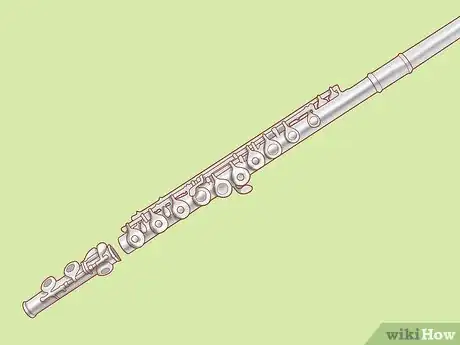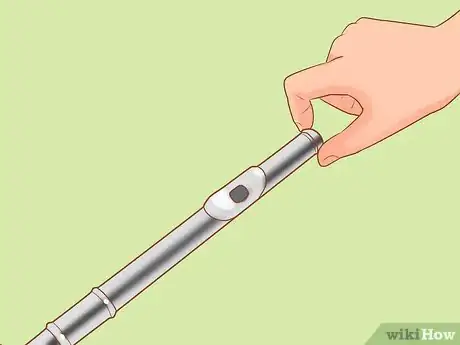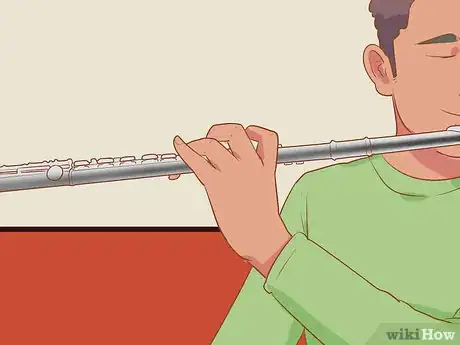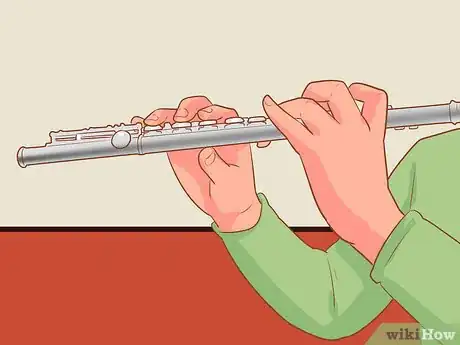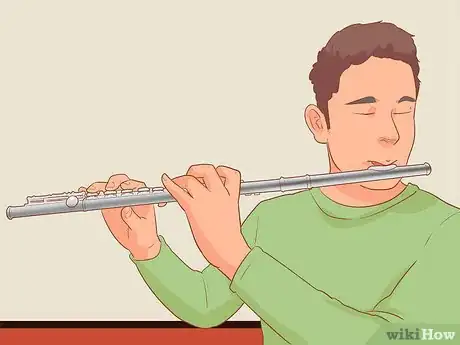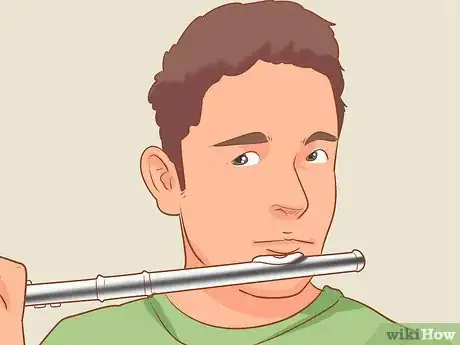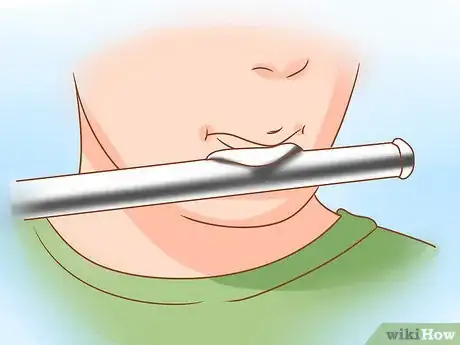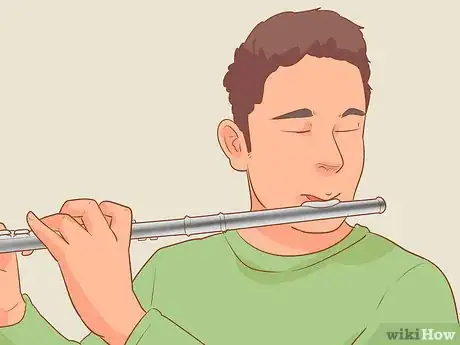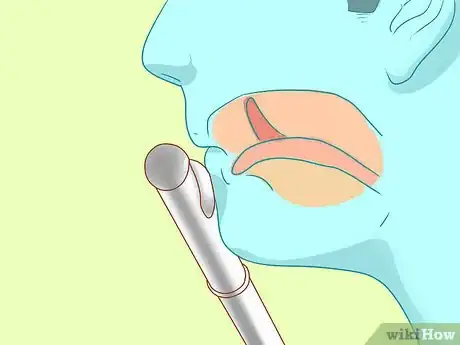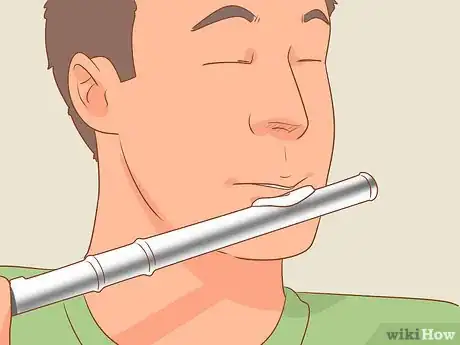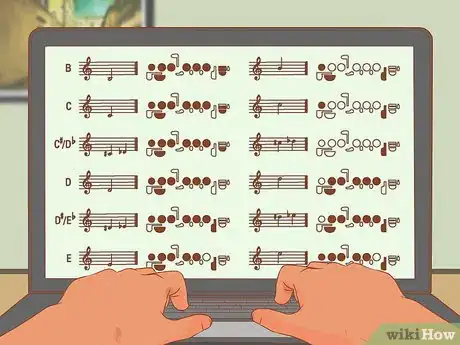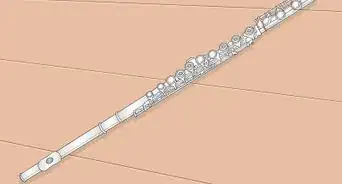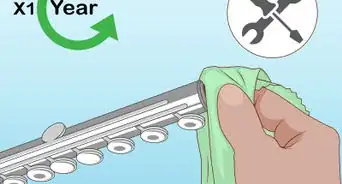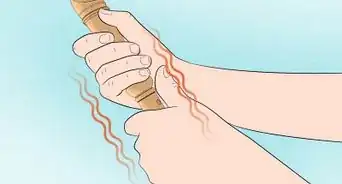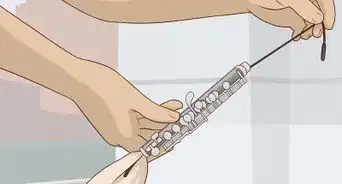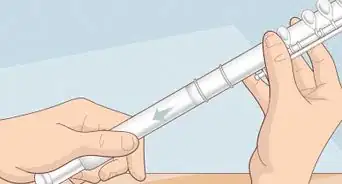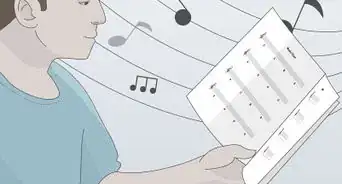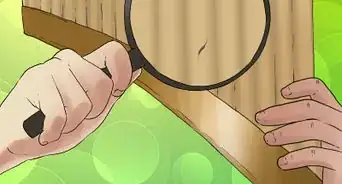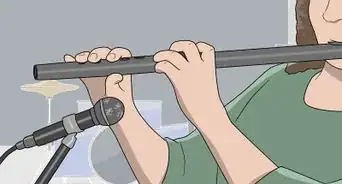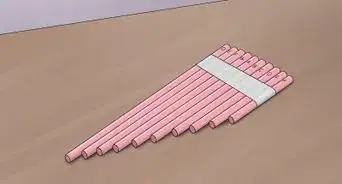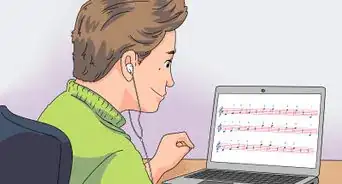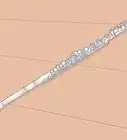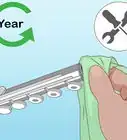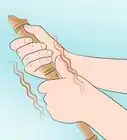This article was co-authored by wikiHow staff writer, Hunter Rising. Hunter Rising is a wikiHow Staff Writer based in Los Angeles. He has more than three years of experience writing for and working with wikiHow. Hunter holds a BFA in Entertainment Design from the University of Wisconsin - Stout and a Minor in English Writing.
There are 13 references cited in this article, which can be found at the bottom of the page.
The wikiHow Video Team also followed the article's instructions and verified that they work.
This article has been viewed 1,382,136 times.
Learn more...
The flute is a woodwind instrument that plays some of the highest notes in an orchestra. While flutes may look intimidating with all of their keys, you can easily start learning how to play. Once you put the instrument together and perfect your embouchure, all you have to do is press the keys in order to change notes. With a bit of practice every day, you can learn how to play your flute well!
Steps
Flute Assembly
-
1Buy or rent a flute from a music store. Talk to the employees to see which flute is the best for a beginner. If you want to have your own instrument, consider buying the flute. Otherwise, check if the shop offers instrument rentals so you can borrow it when you need it.[1]
- You can buy a starter flute for around $50 USD, but they may not be the best quality instrument.
- Many stores have a rent-to-own option where you can pay for your instrument over time.
Tip: If you’re still in school, see if they offer instrument rentals for the academic year. That way, you can play in the school band without having to buy your own instrument.
-
2Slide the head joint into the end of your flute. The head joint is the part of your flute with the lip plate and hole where you breathe into the instrument. Take the head joint and the flute’s main body out of the case. Put the head joint into the side of your flute by pushing and twisting it in place. Push the head joint in snugly against the main body.[2]
- Avoid holding onto any of the rods or keys on the flute’s body while you’re putting your flute together since they could easily get damaged.
Advertisement -
3Line up the hole in the head joint with the first key on the flute. Locate the first key on the main body of your flute. Twist the head joint so the mouth hole is in line with the key. Hold the flute up at eye level and look down the body to make sure the hole is perfectly aligned.[3]
- If the hole is too far forward or backward, it will be more difficult to play your flute with a full tone.
-
4Push the foot joint into place so the metal pin lines up with the keys. The foot joint is the last part of your flute with a few rods and keys on it. Push the foot joint into the bottom end of your flute and twist it in place to secure it. Make sure it has a snug fit against the main body. Rotate the foot joint so the long metal pin running down it lines up with the bottom key on your flute body.[4]
-
5Tune your flute by adjusting the head joint. Use a chromatic tuner or download a tuning app on your phone. Play a note and check if it’s flat or sharp, meaning too low or too high. If the instrument is sharp, twist and pull out the head joint slightly. If your flute is flat, make the instrument shorter by pushing the head joint in further. Adjust the flute until it’s in tune.[5]
Hand and Arm Placement
-
1Control the keys closest to the head joint with your left hand. Locate the first key on the bottom of the body of your flute and rest your thumb on it so your palm faces you. Wrap the rest of your fingers around the other side of the flute. Put your index, middle, and ring fingers on the 2nd, 4th, and 5th keys respectively. Rest your pinky on the side key that looks like a paddle.[6]
- Use the crook of your hand between your thumb and index finger to support the weight of the flute.
-
2Use your right hand to control the keys at the end of the flute. Use your thumb to support the bottom of the flute. Make sure your palm faces away from you so you can easily press the keys. Locate the bottom 3 keys on the main body of your flute. Put your index, middle, and ring fingers on each of the keys. Use your right pinky to press the first key on the foot joint.[7]
- Keep your fingers curled so your hands make a C-shape while holding your flute.
- Don’t press down on the keys immediately. Instead, keep your fingers resting on top of them.
Tip: Your fingers will not move to different keys while you play. Never shift your fingers to press different keys or else your fingering will be off for other notes.
-
3Hold the flute parallel to the floor. The end of the flute can point slightly downward. Sit on the edge of a chair so your back is straight and you’re looking ahead. Keep your arms relaxed and away from your body as you raise the flute to your mouth. Make sure the flute is parallel to the ground rather than angling it down.[8]
- If you want to play your flute standing up, keep your feet shoulder-width apart and firmly planted on the ground.
Proper Embouchure
-
1Position the hole underneath the center of your bottom lip. While you’re holding the flute parallel to the floor, set the lip plate underneath your bottom lip. Balance the flute between your chin and bottom lip for the most support. Make sure the hole is directly in the center of your lips to achieve the best tone.[9]
- If the hole is misaligned, you may not produce a full sound while playing your flute.
-
2Tighten the corners of your mouth while keeping your lips smooth and relaxed. Firm up the muscles in the corners of your mouth, but not so tightly that your lips are wrinkled or pursed. Pretend that you’re saying the letter “M” to get the right lip posture, or embouchure.[10]
Tip: You can practice your embouchure using just the head joint of your flute if you don’t want to use the full instrument right away.
-
3Blow air from the middle of your lips toward the hole. Slightly open your mouth like you’re about to say the letter “P” to blow air into the instrument. Exhale a deep breath in a controlled stream toward the hole to play the flute. The air will travel through the body of the flute and create notes.[11]
- Don’t open your mouth too wide or else the air won’t travel into the instrument.
- If you don’t hear any sound coming from the instrument, try slightly pushing your jaw forward or backward to direct the airflow.
-
4Move your tongue back and forth to make short notes. While you’re playing your flute, move your tongue like you’re saying the word “too.” This will help separate the notes you’re playing from one another rather than them sounding like they’re gliding together. Alternate moving your tongue faster and slower to transition between a quick series of short notes and longer, separate notes.[12]
- These notes are referred to as “staccato.”
-
5Change the speed of your breath to adjust the pitch of your note. Take a deep breath and exhale slowly across the hole on your flute to hit notes in a lower register. Then with your next breath, tighten the corners of your mouth slightly more and exhale quickly to make a higher-pitched note. Practice alternating between high and low notes so you can develop better range while you play.[13]
- Make sure your lips stay smooth and unwrinkled or else you may not play with a full tone.
- When playing high notes, try to aim your airstream upward.
-
6Look at a fingering chart to learn how to play different notes. Fingering charts can help you learn how to play through the notes in a scale. Look for a fingering chart for the type of flute you have so you can see which keys you need to press for each note. Work through each fingering while you play so you can easily change between the notes.[14]
- Many instructional flute books will come with a fingering chart so you can easily reference them.
Tip: Print out a copy of the fingering chart so you can keep it on a music stand while you first learn to play.
Community Q&A
-
QuestionWhy is it difficult for me to blow?
 Community AnswerYou need to find you 'spot' first. Your spot is the place you put your mouth to blow into your flute. It can take about one week (or even more) of daily practice to learn where you put your mouth exactly, it is different for everyone. After a couple of lessons, you won't even have to think about it when playing. Also, make sure that you are blowing towards the hole -- if you can't quite blow at it exactly, try moving your mouth's positioning.
Community AnswerYou need to find you 'spot' first. Your spot is the place you put your mouth to blow into your flute. It can take about one week (or even more) of daily practice to learn where you put your mouth exactly, it is different for everyone. After a couple of lessons, you won't even have to think about it when playing. Also, make sure that you are blowing towards the hole -- if you can't quite blow at it exactly, try moving your mouth's positioning. -
QuestionIs Yamaha a good brand for an intermediate flute player who wishes to continue playing flute for a long time, and wants the flute last for a very long time?
 Kim GTop AnswererYamaha has a wide variety of flutes, ranging from beginner to professional models. They have received good reviews online and have a reputation for durability.
Kim GTop AnswererYamaha has a wide variety of flutes, ranging from beginner to professional models. They have received good reviews online and have a reputation for durability. -
QuestionWhere can you get a flute book?
 Community AnswerYou can get them online, but a good book to start with is the Essential Elements Book 2000. It's really easy to learn from.
Community AnswerYou can get them online, but a good book to start with is the Essential Elements Book 2000. It's really easy to learn from.
References
- ↑ http://thevault.musicarts.com/flute-renting-vs-purchasing-beginners/
- ↑ https://youtu.be/VbzRHOPEDGU?t=30
- ↑ https://youtu.be/VbzRHOPEDGU?t=52
- ↑ https://youtu.be/VbzRHOPEDGU?t=76
- ↑ https://youtu.be/IBypL7ql5k8?t=24
- ↑ https://youtu.be/SLO0WkLXwfo?t=92
- ↑ https://youtu.be/SLO0WkLXwfo?t=148
- ↑ https://youtu.be/SLO0WkLXwfo?t=240
- ↑ https://youtu.be/AhO4viOGGTw?t=202
- ↑ https://youtu.be/AhO4viOGGTw?t=27
- ↑ https://youtu.be/AhO4viOGGTw?t=229
- ↑ https://www.yamaha.com/en/musical_instrument_guide/flute/play/
- ↑ https://www.yamaha.com/en/musical_instrument_guide/flute/play/
- ↑ https://www.tamdistrict.org/cms/lib/CA01000875/Centricity/Domain/586/Flute%20Fingering%20Chart.pdf
About This Article
To play the flute, start by holding it so the lip hole is resting on your bottom lip and the rest of the instrument is sticking out to the right horizontally. Next, place your left-hand fingers on the keys closest to your mouth, and set your right-hand fingers on the keys closest to the end of the flute. Before you start playing, make sure you're sitting up straight and looking straight ahead. Then, blow into the lip hole with your lips slightly pursed, like you're spitting out a sunflower seed. Try blowing at slightly different angles until you hear a breathy but smooth sound. Now, to make different notes, all you have to do is press down on the keys! To learn how to clean your flute, keep reading!
